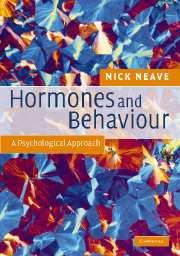Book contents
- Frontmatter
- Contents
- List of diagrams
- Preface
- Acknowledgements
- 1 Background to psychobiology
- 2 Hormones and the endocrine system
- 3 Behavioural endocrinology
- 4 Neurological effects of hormones
- 5 Typical sexual determination/differentiation
- 6 Atypical sexual differentiation
- 7 Neural differentiation
- 8 Reproductive/sexual behaviours
- 9 Attachment/parental behaviours
- 10 Aggressive/competitive behaviours
- 11 Sex steroids and cognition
- References
- Index
9 - Attachment/parental behaviours
Published online by Cambridge University Press: 05 June 2012
- Frontmatter
- Contents
- List of diagrams
- Preface
- Acknowledgements
- 1 Background to psychobiology
- 2 Hormones and the endocrine system
- 3 Behavioural endocrinology
- 4 Neurological effects of hormones
- 5 Typical sexual determination/differentiation
- 6 Atypical sexual differentiation
- 7 Neural differentiation
- 8 Reproductive/sexual behaviours
- 9 Attachment/parental behaviours
- 10 Aggressive/competitive behaviours
- 11 Sex steroids and cognition
- References
- Index
Summary
Uvnäs-Moberg (1997) proposed that basic problems related to survival and reproduction (e.g. giving birth, lactation, infant socialisation, etc.) have led to physiological, psychological and behavioural adaptations in the form of social/attachment bonds. These bonds are formed during certain key reproductive events (sexual interaction, social interaction, birth, lactation, etc.) and the kinds of behaviours associated with such bonds are species-typical and highly individualised (Carter, 1998; Mason and Mendoza, 1998). These bonds are distinct from sex drive, which, according to Fisher (1998), may have evolved simply to motivate individuals to seek sexual activity with a range of partners.
In many diverse species it has been confirmed that individuals do form strong, long-lasting, yet flexible attachment bonds that seem to serve initially to facilitate reproduction, and then provide a sense of security, and reduce feelings of anxiety and stress (Carter, 1998). Mammals in particular display complex social relationships in which pairs, or a number of individuals, form a cohesive social group held together by social bonds and certain social affiliative behaviours (e.g. grooming). Forming an attachment bond to a specific individual must entail both perceptual, cognitive and emotional elements; and the similarity of the differing types of emotional bonds suggests some basic core biological process is at work. Mason and Mendoza (1998) suggest that newborns are equipped to form dynamic neurobiological representations called ‘action schemata’ that guide their behavioural responses to their environment.
- Type
- Chapter
- Information
- Hormones and BehaviourA Psychological Approach, pp. 191 - 223Publisher: Cambridge University PressPrint publication year: 2007



